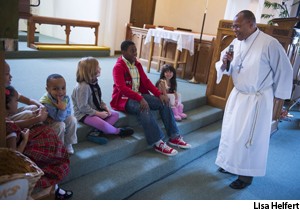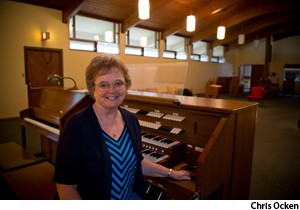When Joyce Gibbs began attending Zion Lutheran in Phillipsburg, Kan., in 1954, the congregation had to set up extra chairs in the aisle during worship services. In 1964 a new building was constructed to accommodate the rapidly growing congregation.
“We were really a thriving congregation. We had good attendance, an active junior and senior Luther League, a couples group …,” said Gibbs, who lives in rural Phillipsburg, with a population of about 2,500.
Today, Zion’s average attendance has dwindled to about 50 and Sunday school is now a one-room class with a handful of mixed-aged youth. Lorna Paulus, the pastor who divides her time between Zion and nearby St. John Lutheran Church in Kensington, Kan., attributes the decline to several factors, including the loss of industry in the town, elderly members who have died and lack of young families coming up behind them.
Now, Zion is in conversation with three other rural congregations about merging. “I think for all of us we see it as necessary to our future,” said Paulus, who has served Zion for 15 years. “If we don’t do something, we won’t be here in another generation.”
Zion’s story is one that echoes across the country as ELCA congregations look for ways to deal with declines in membership and participation.
Nearly 30 percent of ELCA churches reported an average worship attendance of fewer than 50 people in 2010. From 2003 to 2011, average weekly worship attendance dropped 26 percent. And from 2009 to 2010, ELCA membership decreased 5.9 percent, the sharpest rate of decline among mainline denominations, according to the National Council of Churches.
“Since the inception of the ELCA, we’ve seen decline every year, and it has accelerated over the last five years,” said Elizabeth Eaton, bishop of the Northeastern Ohio Synod. “It doesn’t matter where a congregation is situated, we have congregational decline in every demographic, every geography.”
It’s no news flash that the ELCA is shrinking. But where is everyone going? And more importantly, where do we go from here?
Losing our religion

Photograph of Gospel Tabernacle Community Church located north of Minot, N.D., on Sunday, Nov. 18, 2012. The church was formerly home to North Trinity Lutheran Church. (Photography by Ann Arbor Miller, annarbormiller.com)
What we’re seeing is not just a backlash against hymnals and potlucks. Nearly every U.S. Christian denomination has seen membership declines in the past two years, including Southern Baptists, who seemed invincible in the ’70s, ’80s and ’90s.
And in 2012 the Pew Forum on Religion & Public Life reported for the first time that the number of Americans identifying as Protestant dipped below half, to 48 percent. Only Roman Catholics seem to be hanging on, which experts attribute to a growing Latino population.
When it comes to actively practicing religion, which includes worship attendance, the numbers are down across the board. “Of every measure or religious tradition or practice we track in surveys, none of them is going up,” said Mark Chaves, professor of sociology, religion and divinity at Duke Divinity School in Durham, N.C.
“Part of the story is changes in family demographics. The main group that attends church is traditional families and older people. People are marrying later, having fewer kids or having no kids at all. That means the demographic subgroup that typically attends church is a smaller subgroup of the population,” he said.
Fifty years ago not only were traditional families more plentiful, but organized religion had more clout.
“It used to be a cultural expectation to say you were going to church. We didn’t have to do anything. We could just sort of coast,” Eaton observed. “But we’re not part of the establishment anymore. The rug has been pulled out under us.”
Robert C. Johnson, pastor of Norwood Park Lutheran in Chicago has experienced this within the congregation. “People have allowed Sunday mornings to be crowded with many other things, such as children’s sports. Even when activities don’t take place on Sundays, people are so tired from Saturdays that on Sundays they just want to stay home and sleep,” said Johnson, who sees an average of 30 people in worship, according to ELCA statistics.
Eaton added: “Eighteen- to 35-year-olds aren’t seeing church as really relevant to what they need to get done. They want meaning in their lives but don’t necessarily see the church as providing that.”
Lutherans also face a challenge because of the church’s central and northern European roots. When many ELCA congregations were planted, Scandinavians and Germans were migrating to the U.S. in droves. Now, Lars and Gretchen have scattered and neighborhoods have become more ethnically diverse. Meanwhile, churches are still catering to their charter members.
Neil Harrison, director for Renewed Evangelizing Congregations, said, “Too often not only are people out of relationship with each other, but especially congregations are out of relationship with their neighbors and community.”
A chance to change
Christ Lutheran in Catonsville, Md., had been struggling with decline for about 10 years when in 2011 the church decided it needed a new vision. It applied for and received a grant from the ELCA churchwide organization and is now undergoing redevelopment, a path of renewal in which a new pastor is called to radically change the congregation’s identity and focus.
Congregational renewal is a process of spiritual self-discovery and transformation through which churches aim to become healthy, vital ministries. It’s an intense process of proactively confronting decline with the willingness to change.
“For a congregation to pursue renewal, it needs to identify that things are not the way they want them to be and be willing to explore,” Harrison said.
While ELCA grants support a three-year process, it often takes five to seven years to turn around a congregation, he said. The work is challenging, but it has led some churches to incredible growth.
At Christ Lutheran the biggest boost came from increasing community involvement, developing Bible study groups and reaching out to youth with programming, said Ken Powell, a former Army major who was called as vicar to lead the redevelopment. In November 2012, 21 months into the process, Christ’s giving and attendance had doubled from what they were two years prior.
“We have done some remarkable things here as a church. We really are believing in our ability to recover and renew,” said Cindy Redman, congregational council president and a charter member.
Many renewing congregations set tangible goals to increase membership and attendance. But they must also be ready to accept other possibilities, Harrison said.

Ken Powell, vicar, visits with the children of Christ Lutheran, Catonsville, Md., a church undergoing redevelopment.
“Most of the time when congregations think about renewal, they think about transforming their own congregation, but sometimes we learn that they really don’t have the missional energy or critical mass to undergo transformation,” he said. “In these cases the congregation might be better off merging or consolidating.”
In 2011, 163 congregations received $2.5 million in Congregational Renewal Partnership Support grants. Harrison noted, however, that a church doesn’t need a grant to pursue renewal. In fact, he said, “all congregations have to be in renewal all the time. Communities of faith that are not on a journey to be a renewed, evangelizing congregation are on a path to decline and potential closure.”
A major component of renewal that all congregations can and should pursue is to develop their identity, Eaton said. “We’ve told people [in the Northeastern Ohio Synod] that it’s not going to work to be ‘Generic Lutheran Church’ anymore. Every congregation is going to have to pray about and discern what its particular gift is,” she said.
Synod leaders arranged all 183 congregations into 27 geographic clusters to encourage them to talk to one another about their unique strengths and weaknesses. The goal is for congregations to create niche ministries within their communities.
“We’re trying to get churches to engage in communities, to listen to people in the community and see what they need,” Eaton said. “We’re coming to them and saying, ‘Tell us what your hopes and fears are and we’re going to shut up and listen.’ ”
Sometimes we just need to start listening in our congregations. When Chimezie Ukaonu came to serve Zion Lutheran Church, Kulm, N.D., in November 2011, he was surprised that in a town of 351 people, so many folks kept to themselves. The pastor began visiting members in their homes and workplaces, trying to reconnect them with God and each other.
Ukaonu recalled one experience: “While riding with a farmer in a combine, I said to him, ‘It’s amazing — Christ said to go out and feed the hungry, and you’re actually doing it.’ He was surprised because he’d never actually connected his work to ministry.”
Thanks in part to Ukaonu’s pastoral care, in one year Zion’s average worship attendance increased from the 40s to the 60s, and it continues to grow. “It’s about building caring, trusting relationships without an agenda,” he said.
Small, but sturdy
A church can’t always be deemed “too small” based on its membership and attendance, said Julian Gordy, bishop of the Southeastern Synod. “I’ve seen parishes with very few people thriving, who have figured out how to care for one another and get the resources needed to do ministry,” he said.
William Gafkjen, bishop of the Indiana-Kentucky Synod, agrees: “Congregations can be viable and vital with 20 to 30 people in worship on Sunday if they are willing to do some type of shared mission or ministry with another ELCA congregation.”
One example of such an arrangement is Pittsburgh Lutheran United Ministries (PLUM), a cooperative of seven churches. The organization formed in 2004 when pastors John Gropp and Beth Siefert saw that two congregations were unable to support full-time ministers.
“Instead of these congregations closing and trying to merge with other churches, where they would lose entire worshiping communities, we decided to take them under our wing,” Gropp said. “It allows an individual congregation to maintain its presence in the community and to maintain its own identity.”
Today four pastors serve the PLUM congregations throughout the week and preside over worship services on Sundays, alternating locations. Each congregation maintains its own building and coordinates mission and ministries, with assistance from the pastors when necessary.
Gropp points out that often small, struggling churches are assigned interim pastors. “From what we’ve heard, interim pastors aren’t usually up for the fight of encouraging people to try new things, which can cause congregations to go into a lull. We’re out there supporting and stabilizing ministry so congregations can go out and do some creative things, enabling witness of Christ in the community.”
Shiloh Lutheran Church in Walton, Ind., and Christ Lutheran in Kokomo, Ind., recently formed a cooperative ministry. Shiloh is a small, aging congregation in a rural community. On a good day, 35 people attend worship. Christ is slightly larger, located 17 miles away. Two years ago, both churches were struggling to support a full-time pastor.
Sharon Walker, who participated in the ELCA’s Theological Education for Emerging Ministries program, which places candidates in emerging ministries or those without pastoral leadership, was assigned to help both churches. In December 2012, Shiloh and Christ drafted a shared ministry document. Today, Walker divides her time with each congregation based on weekly worship attendance and special needs that arise.
“To me, it’s very exciting and energizing,” Walker said. “When I’m at one, it makes me think about how I can share what is going on there with the other. If there are things we can share, the two of us make a stronger one than if we had to do things on our own.”
Helping churches say goodbye

Mary Ann Sindelar was the pianist and organist at Good Shepherd Lutheran Church, Waukesha, Wis., which closed its doors in September.
Cooperative ministry can be effective, especially for congregations where important work is happening. But at some point it does come down to numbers.
“If you have 12 people on a Sunday, you could be wonderful, spiritual folks, but I’m not sure how viable you are,” Eaton said. “When you get to be so small that you can’t pay the bills, people just get tired.”
Gordy agreed: “When a congregation is solely focused on survival and spends all its resources on that, I think it’s reached a point where it needs to look at whether it still has a mission in the community.”
More than 1,000 ELCA churches have closed over the past 10 years, some merging with others, some simply shutting their doors and members dispersing. Regardless of the outcome, saying goodbye to a community, a building and even a name can be painful.
“There is a certain numbness after a church closes,” said Ed Ruen, former interim pastor of Good Shepherd Lutheran Church, Waukesha, Wis. The church closed its doors in September 2012 after a lengthy process of considering undergoing renewal or merging with a nearby congregation. Ruen said of the congregation, “They just threw themselves into this parish for years. You don’t just pick up and move on right away.”
Mary Ann Sindelar, who had been a member of Good Shepherd for 67 years, said, “When the church finally closed, I started thinking about how this had only been my second church. I felt like a man without a country.” Sindelar had served on the council and worship team, was a Sunday school teacher, sang in the choir, and for 20 years was the organist and pianist.
She said what helped the most was the church’s connectedness during the last years. “The last two years we were open no one left the church, and the majority of people came to worship every Sunday. We were one big, well, small family,” she said.
Additional fellowship opportunities were planned so people could gather and talk about what was happening. There was also a homecoming Sunday in which past members returned to commemorate the church. “It was really helpful to realize that this was everybody going through a death, with the whole grieving process,” Sindelar said.
Gafjken noted that “one thing we can do is help [congregations] find space for lament. Just reminding them that we are a Good Friday, Holy Saturday, Easter Sunday kind of people and that there is always promise on the other side of death, whatever death is.”
Among the more positive outcomes of a closure is when a church uses its remaining resources for a greater purpose, Eaton said. “Some congregations say, ‘We’re going to take this difficult, self-sacrificial step of realizing we can’t function anymore on our own, but what can we do to take our resources and make them available to the greater church?’ ” she said.
That’s what Martin Luther Church in Canton, Ohio, did. When Tim Muse came to serve the congregation in February 2007 it was working on a $70,000 budget deficit with $160,000 in endowments. Despite the average attendance of 75, funds were insufficient to maintain the cost of the downtown building, not to mention support of outreach or evangelizing ministries.
“When we came to the point when we realized sustaining ministry was no longer an option, we had two choices: close down the building and hand over the keys to the bishop, or divest ourselves of the property and turn it into a liquid asset to do something for the sake of ministry,” Muse said.
The congregation decided to sell the building and join with Holy Trinity Lutheran in north Canton. Money from the sale was spread out to support local ministries, with a large portion going to Holy Trinity.
Muse said, “It’s important for any congregation that is really struggling financially to say, ‘Let’s be honest about where we are and see that this can be a positive experience.’ ”
If anyone can attest to this statement, it’s Bethlehem Lutheran Church, formerly located in Portland, Ore. In 2010 the congregation faced the reality that it could no longer support its church home. Members met with Solveig Nilsen-Goodin, their interim pastor, in January 2011 to prioritize three things: a pastor or spiritual leader, programs and the property. Overwhelmingly, the property came in last.
Basing its decisions on the result of this exercise, the congregation graciously handed the building over to the Oregon Synod to benefit the greater church. Members continued to gather as a group for worship at other local ELCA churches, and they now are working to discern their unique calling as a congregation.
Among things the group feels called to do is to help other congregations who must give up their church homes. “In going through this process, they have experienced the joy of being part of the larger church, and they want to share this with other congregations who are fearful and sad,” said Nilsen-Goodin, who is now a part-time consultant for the congregation.
“One reason they are able to be so encouraging and supportive is that they have been so intentional and courageous about asking the questions ‘What are we going to faithfully do with the building?’ and ‘What are we going to faithfully do with ourselves?’ “






